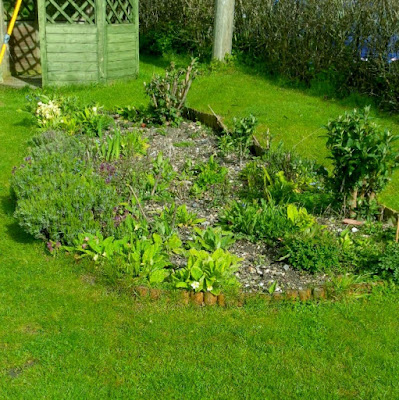By the session leaders
Pond-side
renovation was where it all started for Wallingford Green Gym.
Back in the
early years of this century, when we were just the ‘Abingdon-Wallingford pilot
project’, our first major project was to restore a pond area: in a fenced-off
area of Wallingford Castle Meadows, which – thanks to our efforts – was brought
to the point where it could be opened to the public. Today, the task was on a smaller scale. With
a dozen fit and eager volunteers, there was even a good chance of our being
able to complete this job in a morning.
A small pond had been created near the stream in Ewelme. We had been summoned to landscape the
surround-side.
For those of
us who arrived on site early, it was a time to enjoy the sunshine, and take in
the tranquillity of the scene before start of play:
The
early-bird volunteers also admired the crystal-clear water of the chalk-stream,
where the watercress is just beginning to come into new growth, and sweet
little ducklings may be seen …
debated whether
this should properly be described as a ‘turf-cutter’ or a ‘lawn-edger’ (either
way it proved jolly useful, especially for having been well sharpened
beforehand)
observed that
the planting in the bed we had dug out some years ago, has matured nicely
and mused
about how exactly telegraph poles are put up – typical Green Gym: what the guys
really wanted to do was to take the construction apart, so that they could see
how it all fits together. What they did in fact do was a little weeding of the grass which had grown
inside the plastic tube:
At 10:00
precisely, we were stirred out of our respective reveries by a call to order. The site warden explained the outline of the
plan: pond, downstream, needed “tarting up”, ie earth placed on top of the
liner on the bank. Soil for this purpose
could be obtained from the compost heap near the pond; and turf – inevitably –
only from the furthest point away on the site upstream.
So the call
went out: “We need barrows!”
 |
| “The wagons roll” |
As the
procession of empty barrows made its way across the upper meadow, ever-cheerful
Green-Gymmers found all manner of half-remembered songs and rhymes going
through our heads: something about a marrow in my barrow, talking to a sparrow;
“rollin’, rollin’, rollin’, keep them doggies rolling”; and stories from Wagon Train.
Wagons in place, the first task was to work
out how best to cut those turfs: how long, how
deep, how broad, how high [Ed:
or am I now getting this confused with the words of a hymn?] then how to get them loaded on to the
transport:
While this was being researched and tested,
barrow-wheelers again had time to stop and take in some of the beautiful sights
(and sounds) of nature. From the young
trees nearby was coming a loud buzzing sound:
 |
| Spot the bee |
Soon, however, it was time to get those
wheels rolling again. From then on,
there was a more or less constant to-ing and fro-ing: barrows of turf carted
downstream; empties returned upstream.
This turned quite a few heads in the village,
as part of the route took in the public road.
Down at the pond, this was the sight awaiting
the workforce – a little bit on the bleak and desolate side:
It was not difficult to decide that we should
start by laying turf on the far side, and work our way round from there. Here the first turf is laid:
Prime-quality, beautifully-manicured,
professional turf this was not. If we
had tried to roll it like carpet, it would only have fallen apart; and the
depth of earth needed (to give it a fighting chance of flourishing) meant that
transporting it made for quite some work-out.
There was also the business of fetching earth to ‘bank up’ the turf, and
shaping it into place:
Tea-break came just at the right time.
Plus an extra treat for some lucky volunteers:
watching a Red Kite fly low and fast along the length of the watercress beds,
like a ‘dambuster’.
Re-invigorated by home-made cake we may have
been, but progress was slower in the second half of the session – if only
because we had lost two of our crew. One
had only been able to come for the first half anyway (due to other
commitments). And the other? Well, ‘C’ found herself on ad-hoc sentry duty, until village postie
was spotted and summoned back to retrieve his keys:
For whatever reason, it was not until the
second half that we noticed this beside the stream, although it must have lain
there some considerable time. From the
path, it was not immediately clear that the bird was long dead – not all scenes
in nature are cute:
C’s scepticism notwithstanding, in fact the
job was completed, with almost perfect timing for our normal session end. It was quite a surprise, but a welcome one, to
hear the cry, “No more turf!” The
turf-strippers had been doing a grand job, and by now were well-practised:
Inevitably, one load of turf was already in
transit when the call came; and it just so happened that it was C who had the ‘honour’
of delivering the last consignment – and so being in place to persuade
volunteers that they really could stop now, because the moment of ‘putting the
finishing touches’ had already been captured on camera:























The second-to-last picture looks like a grave for that poor bird.
ReplyDelete